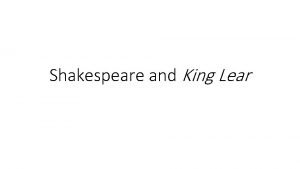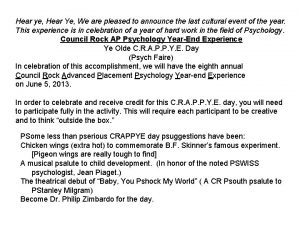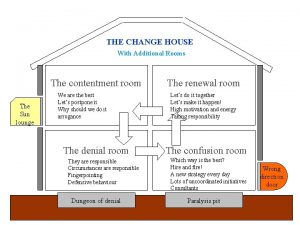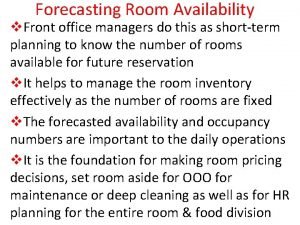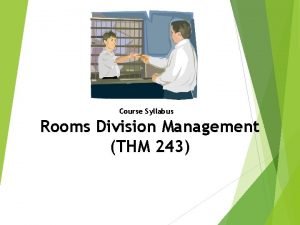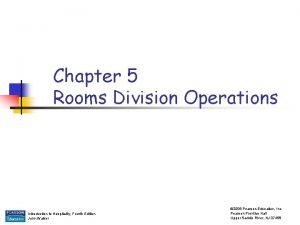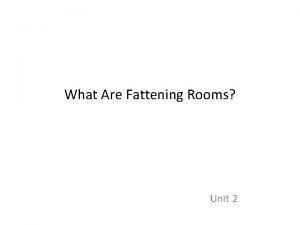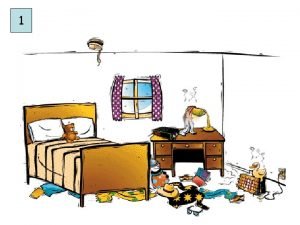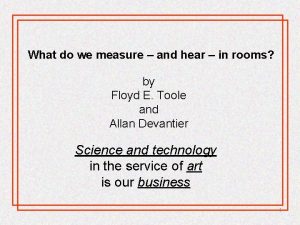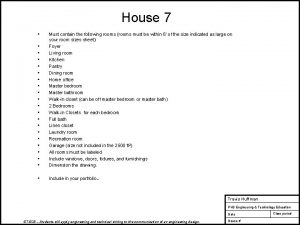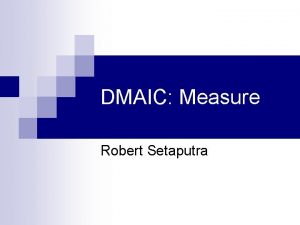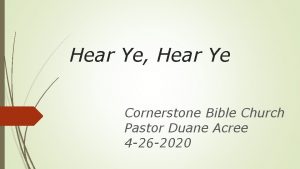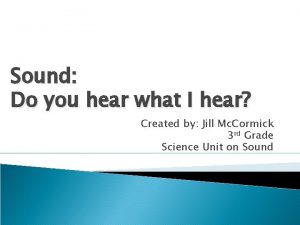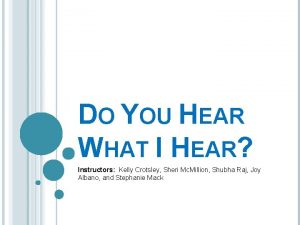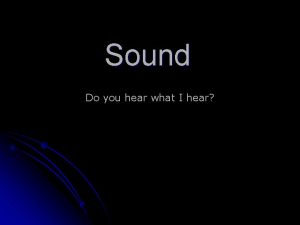What do we measure and hear in rooms




































- Slides: 36

What do we measure – and hear – in rooms? by Floyd E. Toole and Allan Devantier Science and technology in the service of art is our business 1

A very quick review of the science of loudspeaker/room/listener interactions. 2

EXAMPLE: A loudspeaker with directivity problems 10 woofer midrange tweeter 0 d. B -10 -20 20 ON AXIS 30 DEGREES OFF AXIS 60 DEGREES OFF AXIS 50 100 500 1 K 5 K FREQUENCY (Hz) 10 K 20 K 3

Step One: collect data using the “spinorama” 70 amplituderesponse measurements on horizontal and vertical axes 4

Step two: process the data Direct sound = on-axis response Early reflections = energy sum of the appropriate off-axis angles for the type of room being used. Late reflections/reverberation = total sound power = energy sum of all sound radiated in all directions. 5

Predictions of room events from many anechoic measurements 20 PREDICTED“ROOM CURVE” 10 d. B 0 -10 20 DIRECT SOUND EARLY REFLECTIONS LATE REFLECTIONS 50 100 500 1 K 5 K FREQUENCY (Hz) 10 K 20 K 6

Real vs. Predicted Room Curves 30 20 d. B From: Toole, JAES 1985 This is not new! 10 0 -10 20 50 100 500 1 K 5 K FREQUENCY (Hz) 10 K 20 K 7

There is a region where the room dominates, and one where the loudspeaker dominates. 30 20 Room d. B Transition Loudspeaker 10 0 -10 20 50 100 500 1 K 5 K FREQUENCY (Hz) 10 K 20 K 8

For different rooms: fc = Schroeder frequency Small domestic room: 70 m 3, RT= 0. 4 s, Room Transition fc = 150 Hz Loudspeaker Smallest room ST 202: 125 m 3, RT=0. 2 s fc= 80 Hz ≈ 350 seat cinema: 1900 m 3, RT=0. 5 s fc = 32 Hz ≈ 800 seat cinema: 4200 m 3, RT=0. 65 s fc = 24 Hz 20 50 100 500 1 K 5 K FREQUENCY (Hz) 10 K 20 K 9

So, for the rooms in which we are interested: • The loudspeaker and the screen are the dominant factors over most of the frequency range • In cinemas standing waves are not a likely problem, except for LFE • In smaller rooms some means of controlling low-frequency standing waves will be necessary – and there are options. 10

What makes this so important? • From comprehensive anechoic data on loudspeakers it has been possible to: – Predict room curves with good accuracy, and – Predict listener sound quality ratings – when listening in a room – with good accuracy. 11

What was learned? • A flat on-axis response is important. • Both on-axis and off-axis performance must be smooth – and similar in shape. • Smoothness of the curves – i. e. absence of resonances – yields higher scores. • 1/20 -octave data yield better correlations than 1/3 -octave data. Conclusion: fine details are audible. • Bass performance accounts for about 30% 12 of the factor weighting.

So, a combination of on- and off-axis anechoic data can be processed by an algorithm to yield good predictions of sound quality. But, where do room/house curves fit into this? Let us examine what it is that we are measuring. 13

Measurements in a 125 m 3 room – the smallest room included in SMPTE ST 202: 2010 Anechoic spinorama 6 -seat average room curve Sound power alone is not enough at HF. We must add some direct sound to the prediction. 14

Measurements in a 125 m 3 room – the smallest room included in SMPTE ST 202: 2010 Anechoic spinorama This loudspeaker, although imperfect, has been equaled, but not surpassed, in double-blind listening tests. 6 -seat average room curve The targets are not appropriate, certainly not for a room that cannot accommodate 30 persons 15

A Problem: A loudspeaker/room combination that is a good example of the “state-of-the-art” in sound reproduction would be degraded by forcing it to meet any of the ISO/SMPTE target room curves. 16

Measurements in a 125 m 3 room – the smallest room included in SMPTE ST 202: 2010 Anechoic spinorama This loudspeaker, is flawed, and it receives mediocre scores in doubleblind listening tests. 6 -seat average room curve 17

For known environments it is possible to develop simple predictive algorithms. For typically furnished domestic rooms and home theaters a sum of: 12% listening window (direct sound), 44% early reflections and 44% sound power works well. Different rooms may need different proportions. 18

Directivity is a MAJOR factor in what is measured in a room. • At low and middle frequencies in-room curves are dominated by far off-axis, reflected, sound. • However at the highest frequencies, the direct sound is likely to be dominant. • Let us see how this translates to a large cinema. 19

This suggests that all that is needed is to turn the bass down and go home 20

But, we haven’t corrected for screen loss, and that affects the direct sound from the loudspeaker. We might also wish to compensate for air attenuation. Both of these are known impediments to good sound from loudspeakers, and both can be compensated for. The predicted (dotted) curve anticipates the bass rise (reduced DI), but does not include screen and air 21 attenuation.

When we modify the measured steady-state room curve to correct for screen and air attenuations, as shown in the top curves, we get an estimate of the room curve without those losses – that now approximates the predicted curve, which assumed no such losses. Where did Curve-X come from? 22

Interim summary: • A state-of-the-art domestic forward-firing loudspeaker in a 125 m 3 room yields a relatively flat in-room curve. • A state-of-the-art (1985) cinema loudspeaker in a 5660 m 3 room, when compensated for the screen and air attenuation yields a relatively flat in-room curve. • Both were predicted from direct sound and directivity-index data on the loudspeakers. • The physical, loudspeaker/screen/room, side of the issue seems to be well understood. 23

Why the X curve? • Based on (undocumented) listening tests done in 1971, with the limited, and limiting hardware and software of the day, it was concluded that a high frequency rolloff in a large room was subjectively preferred. Allen notes: “The reason for the apparently desirable HF droop is not very easy to explain”. And it wasn’t. • Since then international committees have massaged the “HF droop” to its present forms with no documented subjective evaluations in support of the decisions. • If a HF droop is necessary, it needs to be demonstrated in 2012, with current hardware, software and scientific methodology. • At the small room end of the size scale there is no justification, and there is abundant science to show it. 24

What is the most basic information we need about a loudspeaker? • The on-axis, preferably the listening window, performance describing the direct sound. This should be smooth and flat. • The sound power radiated by the loudspeaker, or • The directivity index (DI) as a function of frequency. DI is the difference between the sound power and the direct sound. Either of these should be smoothly changing or constant, or a combination of the two. 25

In new installations: • We should be able to obtain these data from loudspeaker manufacturers and, • If the loudspeakers are to be located behind a screen, the screen attenuation must be known, and • In large rooms, compensation for air attenuation should be included – this is in standard tables. 26

In existing installations: • We will need to measure: – Direct sound over an appropriate listening window. This will include the on-axis screen attenuation. This curve should be flat and smooth but lowfrequency data cannot be trusted because of compromised resolution due to windowing. – Sound power, as modified by the screen, air attenuation, and absorption at the room boundaries. Only at lower frequencies can this steady-state data be trusted; at higher frequencies corrections will need to be made for at least the screen and air attenuations. This can be done. 27

In a few installations: • We need to perform controlled, randomized, blind or double-blind subjective evaluations. • These evaluations should include program from known, documented, facilities with traceable pedigree, otherwise we are trapped in the “circle of confusion”. Soundtracks from dubbing stages with 500 -seat X-curve equalization need not apply. • They should include music program and speech, from non-film sources. • The events should be recorded binaurally, so that listeners elsewhere can share at least the timbral essence of the experience. It is the timbre that issue here, not direction and space. 28

• Now, moving forward, we need some thorough 2012 technical data on: – loudspeakers, – screens and their interactions with loudspeakers and baffles, – cinema acoustical treatments, and – in-situ measurements of sufficient detail that they are not fatally contaminated by acoustical interference effects (i. e. we need many mics in many locations). • The following are some suggestions – a basis for discussions. 29

In-situ measurements – looking back to the Westwood Bruin. • Three sets of five measurements were made = 15 curves. • But because of symmetry, only 8 of them were distinctive. 30

In-situ measurements – looking back to the Westwood Bruin. • Three sets of five measurements were made = 15 curves. • But because of symmetry, only 8 of them were distinctive. • If we had decided that the measurements were to learn about the loudspeakers, rather than to measure what we think people are hearing, we could have changed one measurement, and acquired 5 more 31 distinctive measurements.

32

The mic array 33

A ≈ 350 seat assymetrical stadium seating venue 34

This is the “scientific” phase • After we have learned what we can, and have decided on what measurements we wish to move forward with, we can get down to simplifying the process, and to optimizing its application in different venue sizes and geometries. • But first things first. 35

Science in the service of art is our business Thank you! 36
 I heard myself proclaimed
I heard myself proclaimed He who has ears let him hear
He who has ears let him hear Hear ye definition
Hear ye definition Uses of wind vane
Uses of wind vane Gibbons jacobean city comedy download
Gibbons jacobean city comedy download Doors and rooms chapter 6
Doors and rooms chapter 6 Bedroom hindleap warren
Bedroom hindleap warren Masque of the red death 7 deadly sins
Masque of the red death 7 deadly sins What is the resolution of the masque of the red death
What is the resolution of the masque of the red death Uvm dorm rooms
Uvm dorm rooms The dying rooms
The dying rooms The change house
The change house 4 rooms of change model
4 rooms of change model 4 rooms of change model
4 rooms of change model Hindleap warren rooms
Hindleap warren rooms Antonia is carpeting two of the rooms in her house
Antonia is carpeting two of the rooms in her house Percentage of understay
Percentage of understay Fletc glynco dorms
Fletc glynco dorms Rooms division management syllabus
Rooms division management syllabus 4 rooms of change model
4 rooms of change model Webex breakout rooms
Webex breakout rooms Cisco webex breakout rooms
Cisco webex breakout rooms Video sex rooms
Video sex rooms Msn messenger chat rooms
Msn messenger chat rooms Room division organizational chart
Room division organizational chart Moodle rooms
Moodle rooms Fattening rooms
Fattening rooms Bedroom bathroom living room dining room kitchen
Bedroom bathroom living room dining room kitchen Chat rooms online
Chat rooms online Peat rigg bedrooms
Peat rigg bedrooms The masque of the red death rooms
The masque of the red death rooms National gallery venue hire
National gallery venue hire Conference venues coromandel
Conference venues coromandel Describe the room in the picture
Describe the room in the picture Robin wood cumbria
Robin wood cumbria Let's do math in my room
Let's do math in my room Late rooms edinburgh
Late rooms edinburgh
